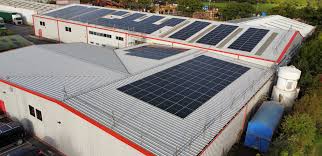Commercial roofs and urban surfaces such as car parks offer enough room in England alone to accommodate Britain’s targeted expansion of solar PV, without building more rural solar farms.
That’s the assessment from experts at UCL’s Energy Institute, in analysis prepared for CPRE, the countryside conservation organisation.
Professor Mark Barrett and Dr Daniel Scamman took as their starting point the ranges in required expansion scenarios for onshore wind, solar, and biomass prepared by the National Grid, the Climate Change Committee and D-BEIS. All are directed at achieving zero emissions by 2050. The academics then related them to types of land likely to accommodate the necessary new capacity.
“More than sufficient urban solar PV capacity could be located on rooftops and car parks without necessitating the development of solar farms in rural areas”, the UCL Energy researchers conclude explicitly.
Switching future solar from farmland to tarmac in towns and warehouse roofs will raise capital costs, the academics concede, resulting in dearer electricity generated. But solar on industrial estates and office blocks faces few planning delays; earlier deployment could cut lifetime costs of their output.
Last week with industry representatives, energy minister Graham Stuart convened a new joint taskforce urging more PV generation on car parks and industrial roofs. No property owner is yet publicly confirmed among the group’s members. It ceases its work next February.
Last month the government’s Powering up Britain blueprint committed it to raising solar capacity to 70GW by 2035.
Onshore wind receives no mention in the plan, an omission reflecting ministers’ failure to slacken planning rules which continue David Cameron’s ban in England since 2016. Though popular among many country dwellers, onshore turbines provoke the wrath of many Conservative voters.
“Onshore wind turbines use little surface area… but have wider visual impacts”, the UCL pair note. “They are expected to play a large role in the UK’s future energy mix, though (their) environmental impacts are currently less well understood and require further research”.
Biomass’s case for more land is less clear, the academics write. “It requires large areas per energy produced compared to solar and wind, and impacts directly on ecosystems. It can compete with land for natural habitats and food production”.
Barrett and Scamman make their predictions within the lowest and highest ranges offered in the three organisations’ scenarios. They do not factor in ancillary costs such as transmission.
On solar, the UCL pair note that England’s hypothetical maximum solar capacity under the energy ministry’ NZES is 83 GW, against what they UCL call solar PV’s “urban technical potential”. They estimate this as 117 GW.
Around 9 GW of England’s present 14 GW working solar capacity is in fields, with only 1 GW on non-domestic roofs, according to BEIS’s Renewable Energy Planning Database (REPD). On a maximum scenario, another 69 GW is needed by mid-century, the UCL pair note. Urban PV set-ups can be ranked upwards by cost systems, with bigger roofs such as shopping malls achieving cost profiles “comparable to solar farms”. Lower cost PV systems require less labour per capacity installed and may therefore be built more quickly, the pair note.
Read the UCL Energy researchers’ land use paper here.




